Analysis of Legal and Law Enforcement Studies
VerifiedAdded on 2020/10/05
|12
|3452
|83
AI Summary
The assignment comprises 13 references from reputable sources, including academic journals, books, and online articles. It covers topics such as the UK Corporate Governance System, the Online Trade in Illicit Pharmaceuticals, Biotechnological Inventions, Consumer Law, Energy Law, and Law Enforcement Intelligence. The references are from publications between 2015 and 2019.
Contribute Materials
Your contribution can guide someone’s learning journey. Share your
documents today.
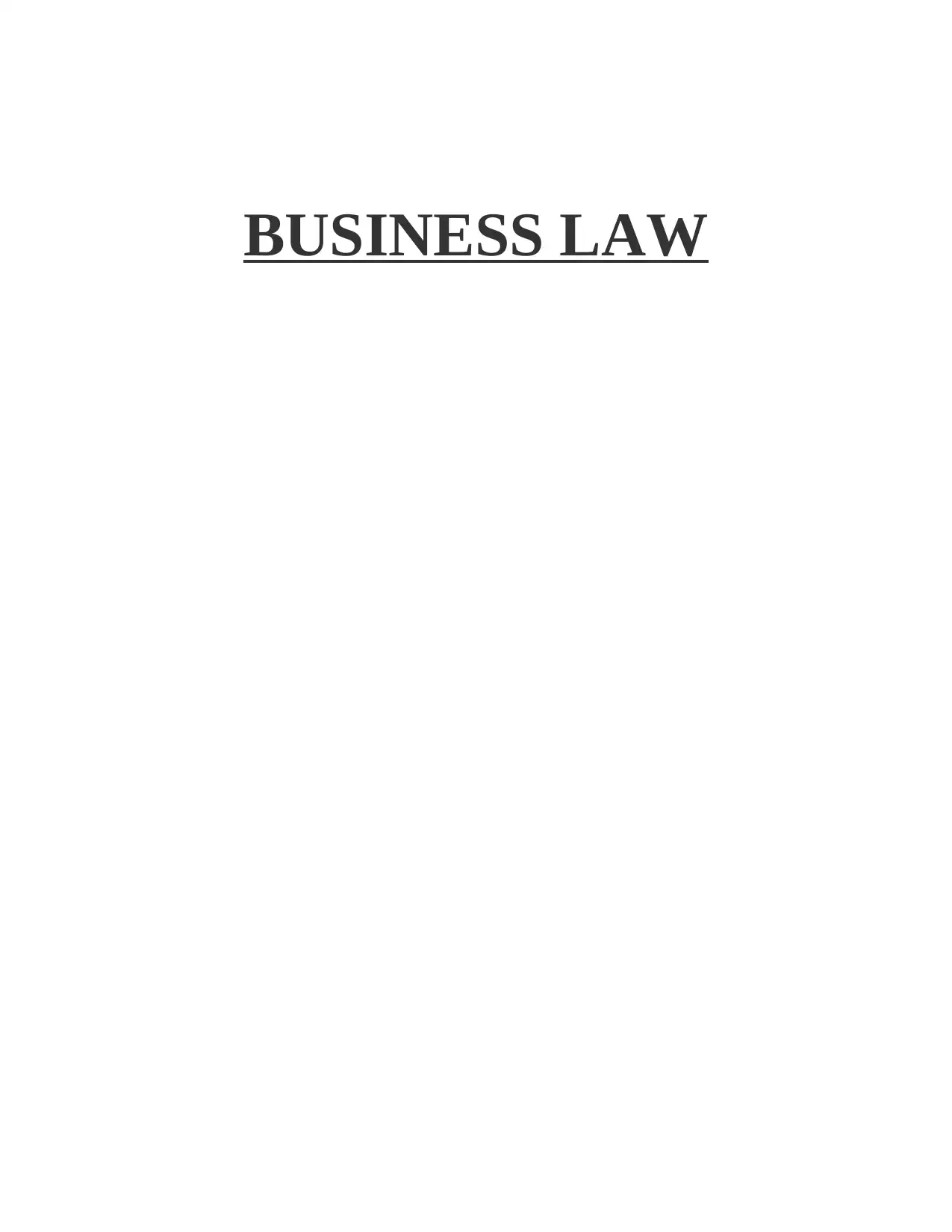
BUSINESS LAW
Secure Best Marks with AI Grader
Need help grading? Try our AI Grader for instant feedback on your assignments.
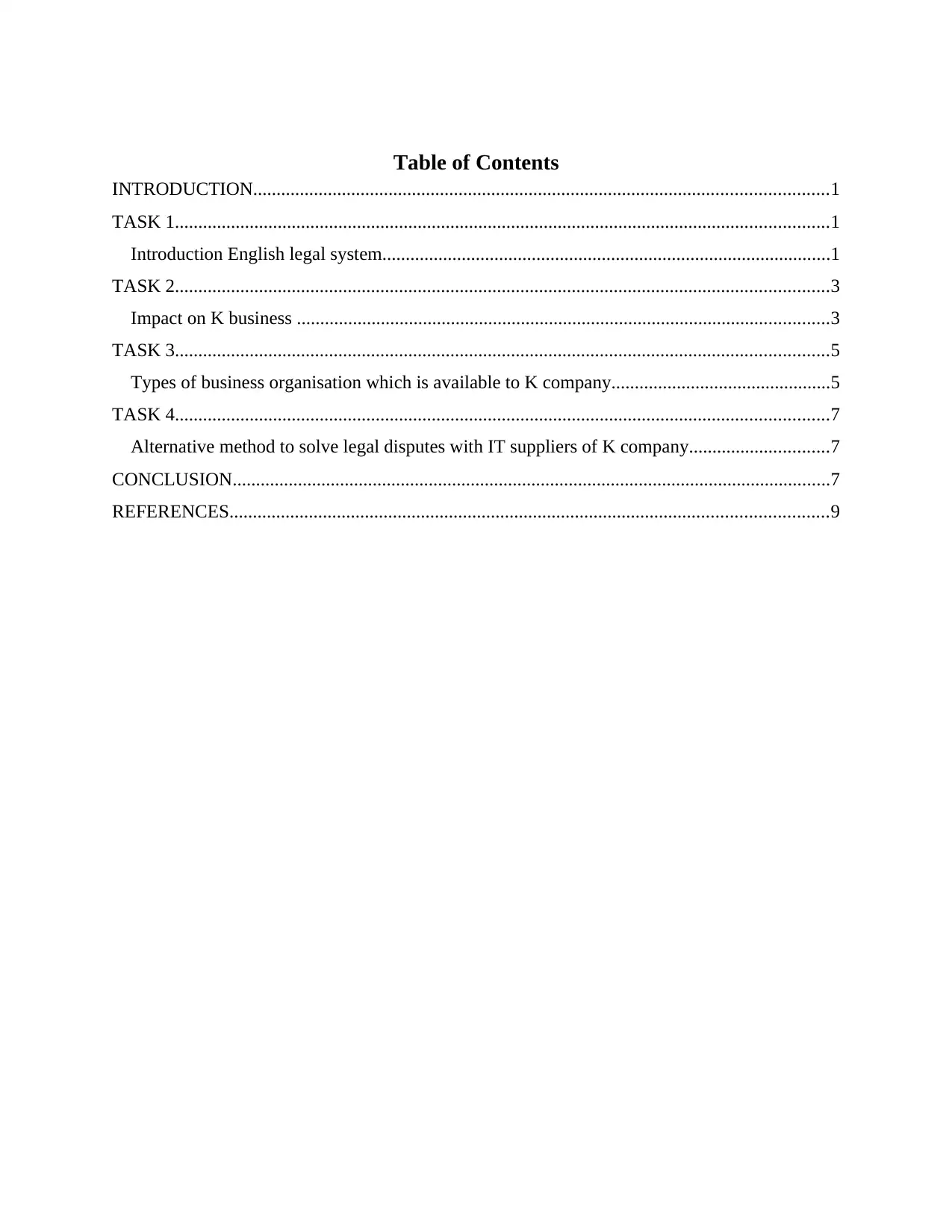
Table of Contents
INTRODUCTION...........................................................................................................................1
TASK 1............................................................................................................................................1
Introduction English legal system................................................................................................1
TASK 2............................................................................................................................................3
Impact on K business ..................................................................................................................3
TASK 3............................................................................................................................................5
Types of business organisation which is available to K company...............................................5
TASK 4............................................................................................................................................7
Alternative method to solve legal disputes with IT suppliers of K company..............................7
CONCLUSION................................................................................................................................7
REFERENCES................................................................................................................................9
INTRODUCTION...........................................................................................................................1
TASK 1............................................................................................................................................1
Introduction English legal system................................................................................................1
TASK 2............................................................................................................................................3
Impact on K business ..................................................................................................................3
TASK 3............................................................................................................................................5
Types of business organisation which is available to K company...............................................5
TASK 4............................................................................................................................................7
Alternative method to solve legal disputes with IT suppliers of K company..............................7
CONCLUSION................................................................................................................................7
REFERENCES................................................................................................................................9
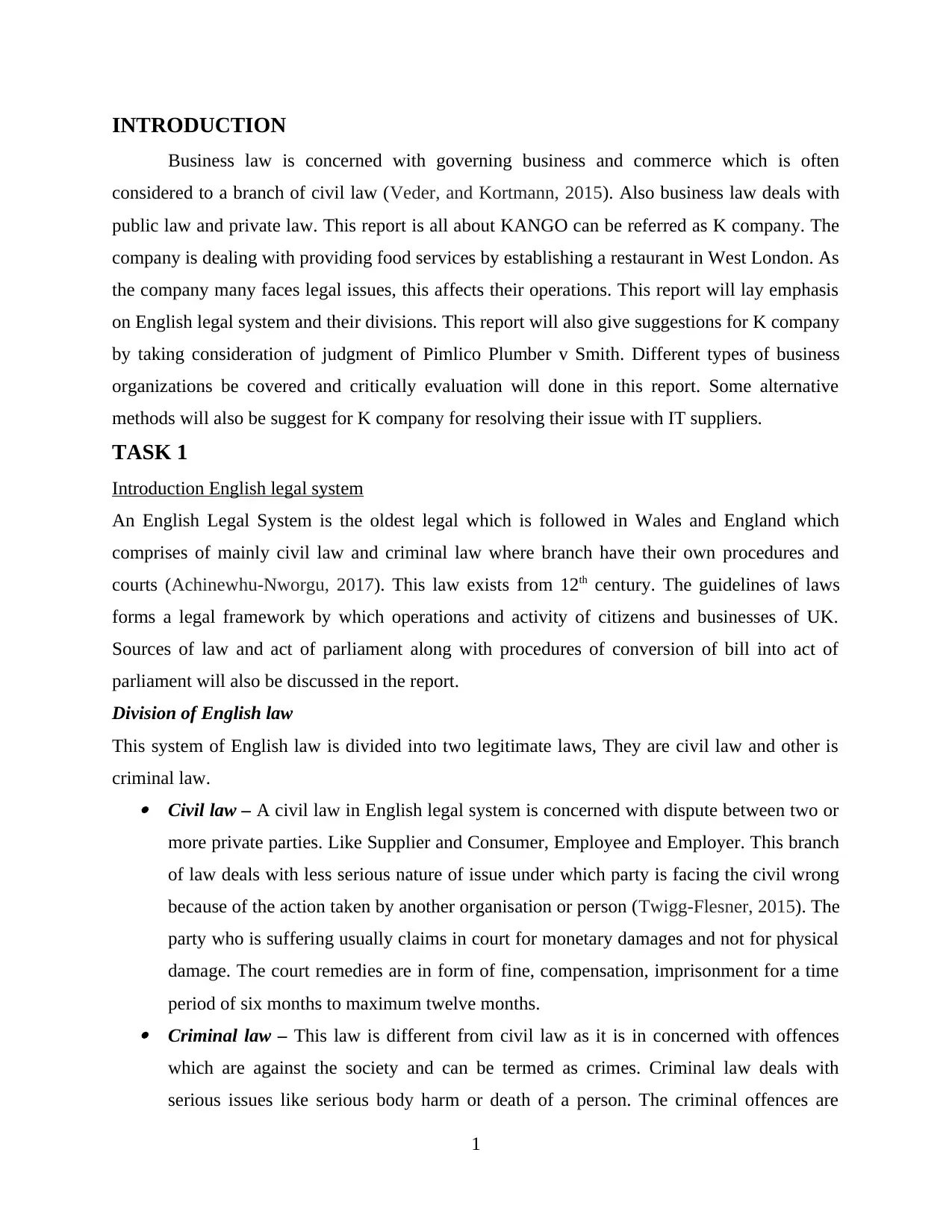
INTRODUCTION
Business law is concerned with governing business and commerce which is often
considered to a branch of civil law (Veder, and Kortmann, 2015). Also business law deals with
public law and private law. This report is all about KANGO can be referred as K company. The
company is dealing with providing food services by establishing a restaurant in West London. As
the company many faces legal issues, this affects their operations. This report will lay emphasis
on English legal system and their divisions. This report will also give suggestions for K company
by taking consideration of judgment of Pimlico Plumber v Smith. Different types of business
organizations be covered and critically evaluation will done in this report. Some alternative
methods will also be suggest for K company for resolving their issue with IT suppliers.
TASK 1
Introduction English legal system
An English Legal System is the oldest legal which is followed in Wales and England which
comprises of mainly civil law and criminal law where branch have their own procedures and
courts (Achinewhu-Nworgu, 2017). This law exists from 12th century. The guidelines of laws
forms a legal framework by which operations and activity of citizens and businesses of UK.
Sources of law and act of parliament along with procedures of conversion of bill into act of
parliament will also be discussed in the report.
Division of English law
This system of English law is divided into two legitimate laws, They are civil law and other is
criminal law. Civil law – A civil law in English legal system is concerned with dispute between two or
more private parties. Like Supplier and Consumer, Employee and Employer. This branch
of law deals with less serious nature of issue under which party is facing the civil wrong
because of the action taken by another organisation or person (Twigg-Flesner, 2015). The
party who is suffering usually claims in court for monetary damages and not for physical
damage. The court remedies are in form of fine, compensation, imprisonment for a time
period of six months to maximum twelve months. Criminal law – This law is different from civil law as it is in concerned with offences
which are against the society and can be termed as crimes. Criminal law deals with
serious issues like serious body harm or death of a person. The criminal offences are
1
Business law is concerned with governing business and commerce which is often
considered to a branch of civil law (Veder, and Kortmann, 2015). Also business law deals with
public law and private law. This report is all about KANGO can be referred as K company. The
company is dealing with providing food services by establishing a restaurant in West London. As
the company many faces legal issues, this affects their operations. This report will lay emphasis
on English legal system and their divisions. This report will also give suggestions for K company
by taking consideration of judgment of Pimlico Plumber v Smith. Different types of business
organizations be covered and critically evaluation will done in this report. Some alternative
methods will also be suggest for K company for resolving their issue with IT suppliers.
TASK 1
Introduction English legal system
An English Legal System is the oldest legal which is followed in Wales and England which
comprises of mainly civil law and criminal law where branch have their own procedures and
courts (Achinewhu-Nworgu, 2017). This law exists from 12th century. The guidelines of laws
forms a legal framework by which operations and activity of citizens and businesses of UK.
Sources of law and act of parliament along with procedures of conversion of bill into act of
parliament will also be discussed in the report.
Division of English law
This system of English law is divided into two legitimate laws, They are civil law and other is
criminal law. Civil law – A civil law in English legal system is concerned with dispute between two or
more private parties. Like Supplier and Consumer, Employee and Employer. This branch
of law deals with less serious nature of issue under which party is facing the civil wrong
because of the action taken by another organisation or person (Twigg-Flesner, 2015). The
party who is suffering usually claims in court for monetary damages and not for physical
damage. The court remedies are in form of fine, compensation, imprisonment for a time
period of six months to maximum twelve months. Criminal law – This law is different from civil law as it is in concerned with offences
which are against the society and can be termed as crimes. Criminal law deals with
serious issues like serious body harm or death of a person. The criminal offences are
1
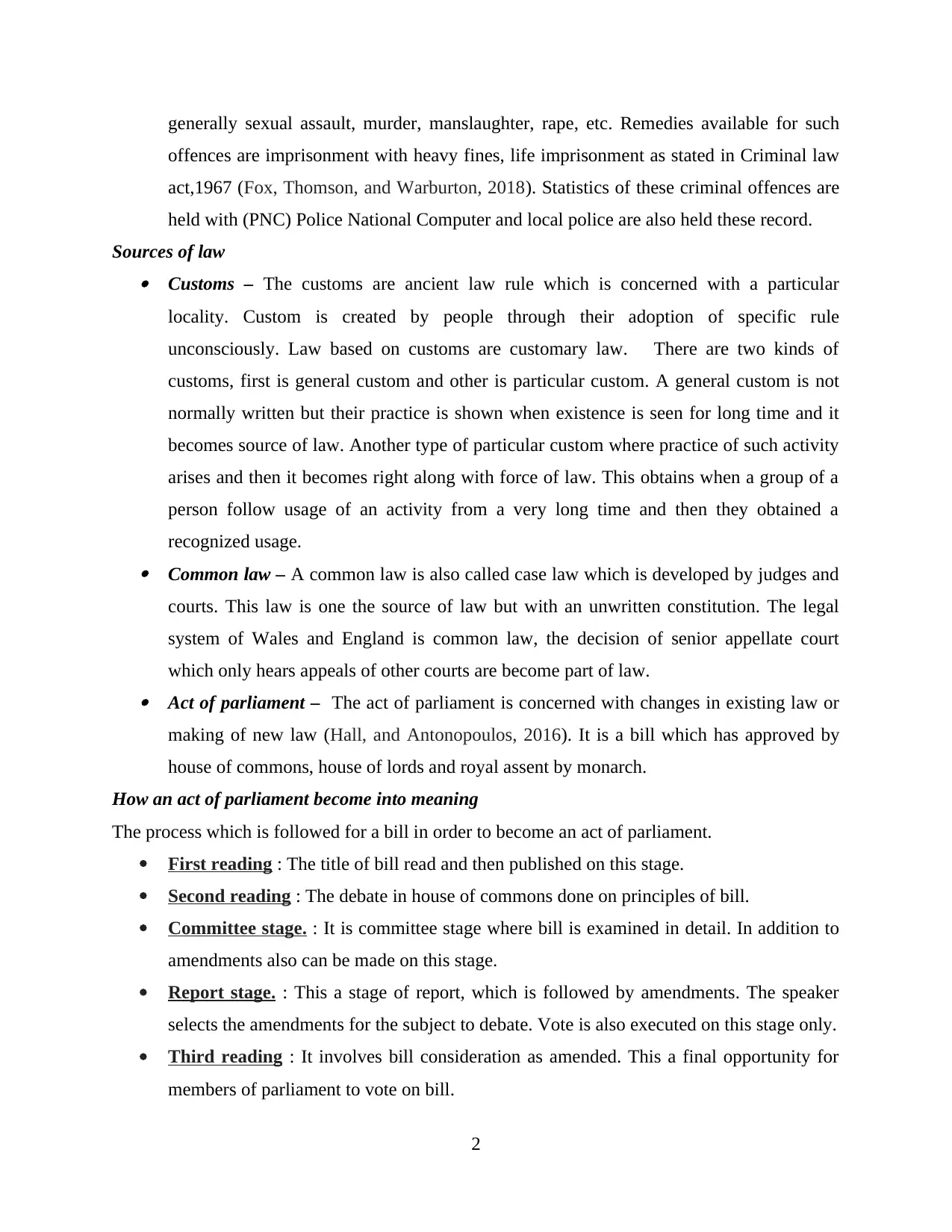
generally sexual assault, murder, manslaughter, rape, etc. Remedies available for such
offences are imprisonment with heavy fines, life imprisonment as stated in Criminal law
act,1967 (Fox, Thomson, and Warburton, 2018). Statistics of these criminal offences are
held with (PNC) Police National Computer and local police are also held these record.
Sources of law Customs – The customs are ancient law rule which is concerned with a particular
locality. Custom is created by people through their adoption of specific rule
unconsciously. Law based on customs are customary law. There are two kinds of
customs, first is general custom and other is particular custom. A general custom is not
normally written but their practice is shown when existence is seen for long time and it
becomes source of law. Another type of particular custom where practice of such activity
arises and then it becomes right along with force of law. This obtains when a group of a
person follow usage of an activity from a very long time and then they obtained a
recognized usage. Common law – A common law is also called case law which is developed by judges and
courts. This law is one the source of law but with an unwritten constitution. The legal
system of Wales and England is common law, the decision of senior appellate court
which only hears appeals of other courts are become part of law. Act of parliament – The act of parliament is concerned with changes in existing law or
making of new law (Hall, and Antonopoulos, 2016). It is a bill which has approved by
house of commons, house of lords and royal assent by monarch.
How an act of parliament become into meaning
The process which is followed for a bill in order to become an act of parliament.
First reading : The title of bill read and then published on this stage.
Second reading : The debate in house of commons done on principles of bill.
Committee stage. : It is committee stage where bill is examined in detail. In addition to
amendments also can be made on this stage.
Report stage. : This a stage of report, which is followed by amendments. The speaker
selects the amendments for the subject to debate. Vote is also executed on this stage only.
Third reading : It involves bill consideration as amended. This a final opportunity for
members of parliament to vote on bill.
2
offences are imprisonment with heavy fines, life imprisonment as stated in Criminal law
act,1967 (Fox, Thomson, and Warburton, 2018). Statistics of these criminal offences are
held with (PNC) Police National Computer and local police are also held these record.
Sources of law Customs – The customs are ancient law rule which is concerned with a particular
locality. Custom is created by people through their adoption of specific rule
unconsciously. Law based on customs are customary law. There are two kinds of
customs, first is general custom and other is particular custom. A general custom is not
normally written but their practice is shown when existence is seen for long time and it
becomes source of law. Another type of particular custom where practice of such activity
arises and then it becomes right along with force of law. This obtains when a group of a
person follow usage of an activity from a very long time and then they obtained a
recognized usage. Common law – A common law is also called case law which is developed by judges and
courts. This law is one the source of law but with an unwritten constitution. The legal
system of Wales and England is common law, the decision of senior appellate court
which only hears appeals of other courts are become part of law. Act of parliament – The act of parliament is concerned with changes in existing law or
making of new law (Hall, and Antonopoulos, 2016). It is a bill which has approved by
house of commons, house of lords and royal assent by monarch.
How an act of parliament become into meaning
The process which is followed for a bill in order to become an act of parliament.
First reading : The title of bill read and then published on this stage.
Second reading : The debate in house of commons done on principles of bill.
Committee stage. : It is committee stage where bill is examined in detail. In addition to
amendments also can be made on this stage.
Report stage. : This a stage of report, which is followed by amendments. The speaker
selects the amendments for the subject to debate. Vote is also executed on this stage only.
Third reading : It involves bill consideration as amended. This a final opportunity for
members of parliament to vote on bill.
2
Secure Best Marks with AI Grader
Need help grading? Try our AI Grader for instant feedback on your assignments.
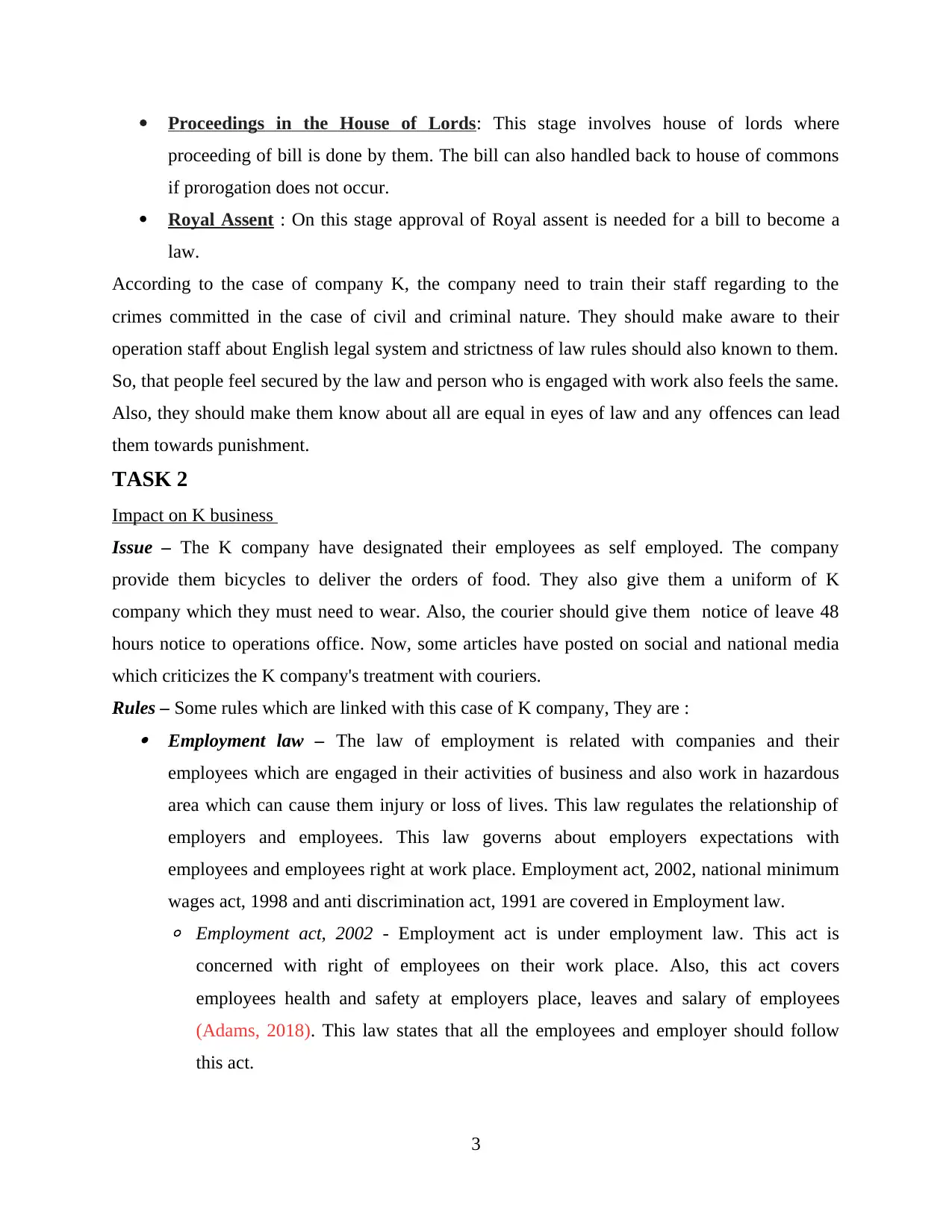
Proceedings in the House of Lords: This stage involves house of lords where
proceeding of bill is done by them. The bill can also handled back to house of commons
if prorogation does not occur.
Royal Assent : On this stage approval of Royal assent is needed for a bill to become a
law.
According to the case of company K, the company need to train their staff regarding to the
crimes committed in the case of civil and criminal nature. They should make aware to their
operation staff about English legal system and strictness of law rules should also known to them.
So, that people feel secured by the law and person who is engaged with work also feels the same.
Also, they should make them know about all are equal in eyes of law and any offences can lead
them towards punishment.
TASK 2
Impact on K business
Issue – The K company have designated their employees as self employed. The company
provide them bicycles to deliver the orders of food. They also give them a uniform of K
company which they must need to wear. Also, the courier should give them notice of leave 48
hours notice to operations office. Now, some articles have posted on social and national media
which criticizes the K company's treatment with couriers.
Rules – Some rules which are linked with this case of K company, They are : Employment law – The law of employment is related with companies and their
employees which are engaged in their activities of business and also work in hazardous
area which can cause them injury or loss of lives. This law regulates the relationship of
employers and employees. This law governs about employers expectations with
employees and employees right at work place. Employment act, 2002, national minimum
wages act, 1998 and anti discrimination act, 1991 are covered in Employment law.
◦ Employment act, 2002 - Employment act is under employment law. This act is
concerned with right of employees on their work place. Also, this act covers
employees health and safety at employers place, leaves and salary of employees
(Adams, 2018). This law states that all the employees and employer should follow
this act.
3
proceeding of bill is done by them. The bill can also handled back to house of commons
if prorogation does not occur.
Royal Assent : On this stage approval of Royal assent is needed for a bill to become a
law.
According to the case of company K, the company need to train their staff regarding to the
crimes committed in the case of civil and criminal nature. They should make aware to their
operation staff about English legal system and strictness of law rules should also known to them.
So, that people feel secured by the law and person who is engaged with work also feels the same.
Also, they should make them know about all are equal in eyes of law and any offences can lead
them towards punishment.
TASK 2
Impact on K business
Issue – The K company have designated their employees as self employed. The company
provide them bicycles to deliver the orders of food. They also give them a uniform of K
company which they must need to wear. Also, the courier should give them notice of leave 48
hours notice to operations office. Now, some articles have posted on social and national media
which criticizes the K company's treatment with couriers.
Rules – Some rules which are linked with this case of K company, They are : Employment law – The law of employment is related with companies and their
employees which are engaged in their activities of business and also work in hazardous
area which can cause them injury or loss of lives. This law regulates the relationship of
employers and employees. This law governs about employers expectations with
employees and employees right at work place. Employment act, 2002, national minimum
wages act, 1998 and anti discrimination act, 1991 are covered in Employment law.
◦ Employment act, 2002 - Employment act is under employment law. This act is
concerned with right of employees on their work place. Also, this act covers
employees health and safety at employers place, leaves and salary of employees
(Adams, 2018). This law states that all the employees and employer should follow
this act.
3
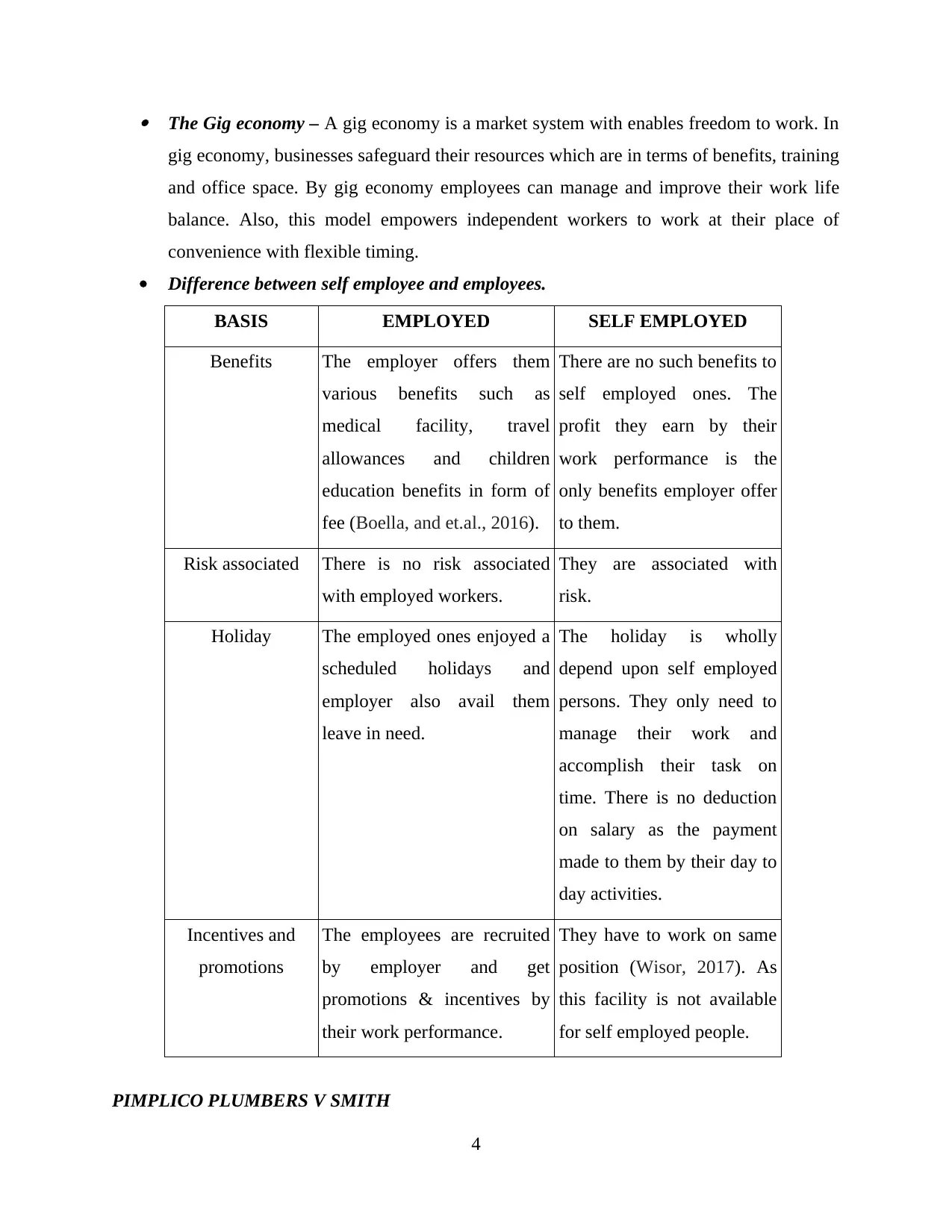
The Gig economy – A gig economy is a market system with enables freedom to work. In
gig economy, businesses safeguard their resources which are in terms of benefits, training
and office space. By gig economy employees can manage and improve their work life
balance. Also, this model empowers independent workers to work at their place of
convenience with flexible timing.
Difference between self employee and employees.
BASIS EMPLOYED SELF EMPLOYED
Benefits The employer offers them
various benefits such as
medical facility, travel
allowances and children
education benefits in form of
fee (Boella, and et.al., 2016).
There are no such benefits to
self employed ones. The
profit they earn by their
work performance is the
only benefits employer offer
to them.
Risk associated There is no risk associated
with employed workers.
They are associated with
risk.
Holiday The employed ones enjoyed a
scheduled holidays and
employer also avail them
leave in need.
The holiday is wholly
depend upon self employed
persons. They only need to
manage their work and
accomplish their task on
time. There is no deduction
on salary as the payment
made to them by their day to
day activities.
Incentives and
promotions
The employees are recruited
by employer and get
promotions & incentives by
their work performance.
They have to work on same
position (Wisor, 2017). As
this facility is not available
for self employed people.
PIMPLICO PLUMBERS V SMITH
4
gig economy, businesses safeguard their resources which are in terms of benefits, training
and office space. By gig economy employees can manage and improve their work life
balance. Also, this model empowers independent workers to work at their place of
convenience with flexible timing.
Difference between self employee and employees.
BASIS EMPLOYED SELF EMPLOYED
Benefits The employer offers them
various benefits such as
medical facility, travel
allowances and children
education benefits in form of
fee (Boella, and et.al., 2016).
There are no such benefits to
self employed ones. The
profit they earn by their
work performance is the
only benefits employer offer
to them.
Risk associated There is no risk associated
with employed workers.
They are associated with
risk.
Holiday The employed ones enjoyed a
scheduled holidays and
employer also avail them
leave in need.
The holiday is wholly
depend upon self employed
persons. They only need to
manage their work and
accomplish their task on
time. There is no deduction
on salary as the payment
made to them by their day to
day activities.
Incentives and
promotions
The employees are recruited
by employer and get
promotions & incentives by
their work performance.
They have to work on same
position (Wisor, 2017). As
this facility is not available
for self employed people.
PIMPLICO PLUMBERS V SMITH
4
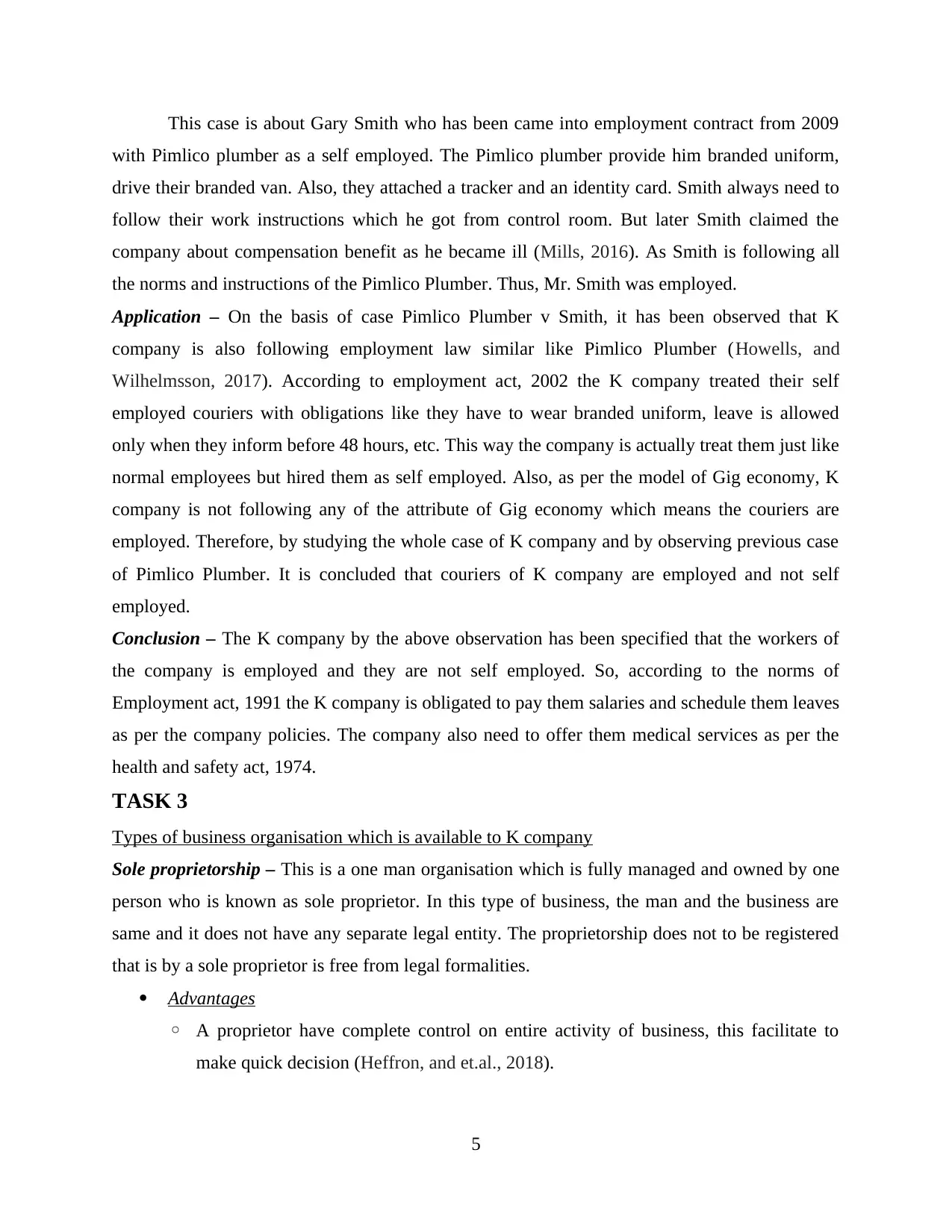
This case is about Gary Smith who has been came into employment contract from 2009
with Pimlico plumber as a self employed. The Pimlico plumber provide him branded uniform,
drive their branded van. Also, they attached a tracker and an identity card. Smith always need to
follow their work instructions which he got from control room. But later Smith claimed the
company about compensation benefit as he became ill (Mills, 2016). As Smith is following all
the norms and instructions of the Pimlico Plumber. Thus, Mr. Smith was employed.
Application – On the basis of case Pimlico Plumber v Smith, it has been observed that K
company is also following employment law similar like Pimlico Plumber (Howells, and
Wilhelmsson, 2017). According to employment act, 2002 the K company treated their self
employed couriers with obligations like they have to wear branded uniform, leave is allowed
only when they inform before 48 hours, etc. This way the company is actually treat them just like
normal employees but hired them as self employed. Also, as per the model of Gig economy, K
company is not following any of the attribute of Gig economy which means the couriers are
employed. Therefore, by studying the whole case of K company and by observing previous case
of Pimlico Plumber. It is concluded that couriers of K company are employed and not self
employed.
Conclusion – The K company by the above observation has been specified that the workers of
the company is employed and they are not self employed. So, according to the norms of
Employment act, 1991 the K company is obligated to pay them salaries and schedule them leaves
as per the company policies. The company also need to offer them medical services as per the
health and safety act, 1974.
TASK 3
Types of business organisation which is available to K company
Sole proprietorship – This is a one man organisation which is fully managed and owned by one
person who is known as sole proprietor. In this type of business, the man and the business are
same and it does not have any separate legal entity. The proprietorship does not to be registered
that is by a sole proprietor is free from legal formalities.
Advantages
◦ A proprietor have complete control on entire activity of business, this facilitate to
make quick decision (Heffron, and et.al., 2018).
5
with Pimlico plumber as a self employed. The Pimlico plumber provide him branded uniform,
drive their branded van. Also, they attached a tracker and an identity card. Smith always need to
follow their work instructions which he got from control room. But later Smith claimed the
company about compensation benefit as he became ill (Mills, 2016). As Smith is following all
the norms and instructions of the Pimlico Plumber. Thus, Mr. Smith was employed.
Application – On the basis of case Pimlico Plumber v Smith, it has been observed that K
company is also following employment law similar like Pimlico Plumber (Howells, and
Wilhelmsson, 2017). According to employment act, 2002 the K company treated their self
employed couriers with obligations like they have to wear branded uniform, leave is allowed
only when they inform before 48 hours, etc. This way the company is actually treat them just like
normal employees but hired them as self employed. Also, as per the model of Gig economy, K
company is not following any of the attribute of Gig economy which means the couriers are
employed. Therefore, by studying the whole case of K company and by observing previous case
of Pimlico Plumber. It is concluded that couriers of K company are employed and not self
employed.
Conclusion – The K company by the above observation has been specified that the workers of
the company is employed and they are not self employed. So, according to the norms of
Employment act, 1991 the K company is obligated to pay them salaries and schedule them leaves
as per the company policies. The company also need to offer them medical services as per the
health and safety act, 1974.
TASK 3
Types of business organisation which is available to K company
Sole proprietorship – This is a one man organisation which is fully managed and owned by one
person who is known as sole proprietor. In this type of business, the man and the business are
same and it does not have any separate legal entity. The proprietorship does not to be registered
that is by a sole proprietor is free from legal formalities.
Advantages
◦ A proprietor have complete control on entire activity of business, this facilitate to
make quick decision (Heffron, and et.al., 2018).
5
Paraphrase This Document
Need a fresh take? Get an instant paraphrase of this document with our AI Paraphraser
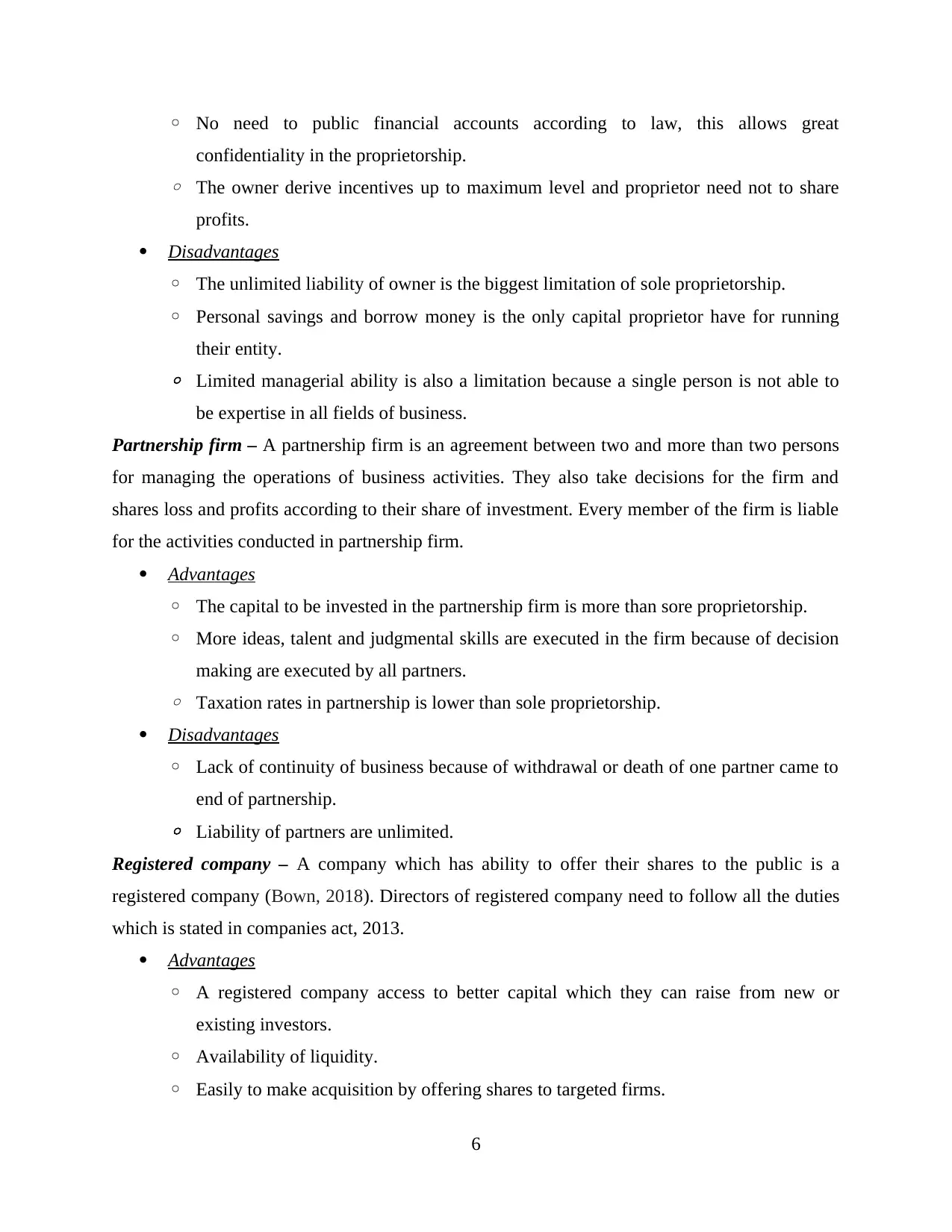
◦ No need to public financial accounts according to law, this allows great
confidentiality in the proprietorship.
◦ The owner derive incentives up to maximum level and proprietor need not to share
profits.
Disadvantages
◦ The unlimited liability of owner is the biggest limitation of sole proprietorship.
◦ Personal savings and borrow money is the only capital proprietor have for running
their entity.
◦ Limited managerial ability is also a limitation because a single person is not able to
be expertise in all fields of business.
Partnership firm – A partnership firm is an agreement between two and more than two persons
for managing the operations of business activities. They also take decisions for the firm and
shares loss and profits according to their share of investment. Every member of the firm is liable
for the activities conducted in partnership firm.
Advantages
◦ The capital to be invested in the partnership firm is more than sore proprietorship.
◦ More ideas, talent and judgmental skills are executed in the firm because of decision
making are executed by all partners.
◦ Taxation rates in partnership is lower than sole proprietorship.
Disadvantages
◦ Lack of continuity of business because of withdrawal or death of one partner came to
end of partnership.
◦ Liability of partners are unlimited.
Registered company – A company which has ability to offer their shares to the public is a
registered company (Bown, 2018). Directors of registered company need to follow all the duties
which is stated in companies act, 2013.
Advantages
◦ A registered company access to better capital which they can raise from new or
existing investors.
◦ Availability of liquidity.
◦ Easily to make acquisition by offering shares to targeted firms.
6
confidentiality in the proprietorship.
◦ The owner derive incentives up to maximum level and proprietor need not to share
profits.
Disadvantages
◦ The unlimited liability of owner is the biggest limitation of sole proprietorship.
◦ Personal savings and borrow money is the only capital proprietor have for running
their entity.
◦ Limited managerial ability is also a limitation because a single person is not able to
be expertise in all fields of business.
Partnership firm – A partnership firm is an agreement between two and more than two persons
for managing the operations of business activities. They also take decisions for the firm and
shares loss and profits according to their share of investment. Every member of the firm is liable
for the activities conducted in partnership firm.
Advantages
◦ The capital to be invested in the partnership firm is more than sore proprietorship.
◦ More ideas, talent and judgmental skills are executed in the firm because of decision
making are executed by all partners.
◦ Taxation rates in partnership is lower than sole proprietorship.
Disadvantages
◦ Lack of continuity of business because of withdrawal or death of one partner came to
end of partnership.
◦ Liability of partners are unlimited.
Registered company – A company which has ability to offer their shares to the public is a
registered company (Bown, 2018). Directors of registered company need to follow all the duties
which is stated in companies act, 2013.
Advantages
◦ A registered company access to better capital which they can raise from new or
existing investors.
◦ Availability of liquidity.
◦ Easily to make acquisition by offering shares to targeted firms.
6
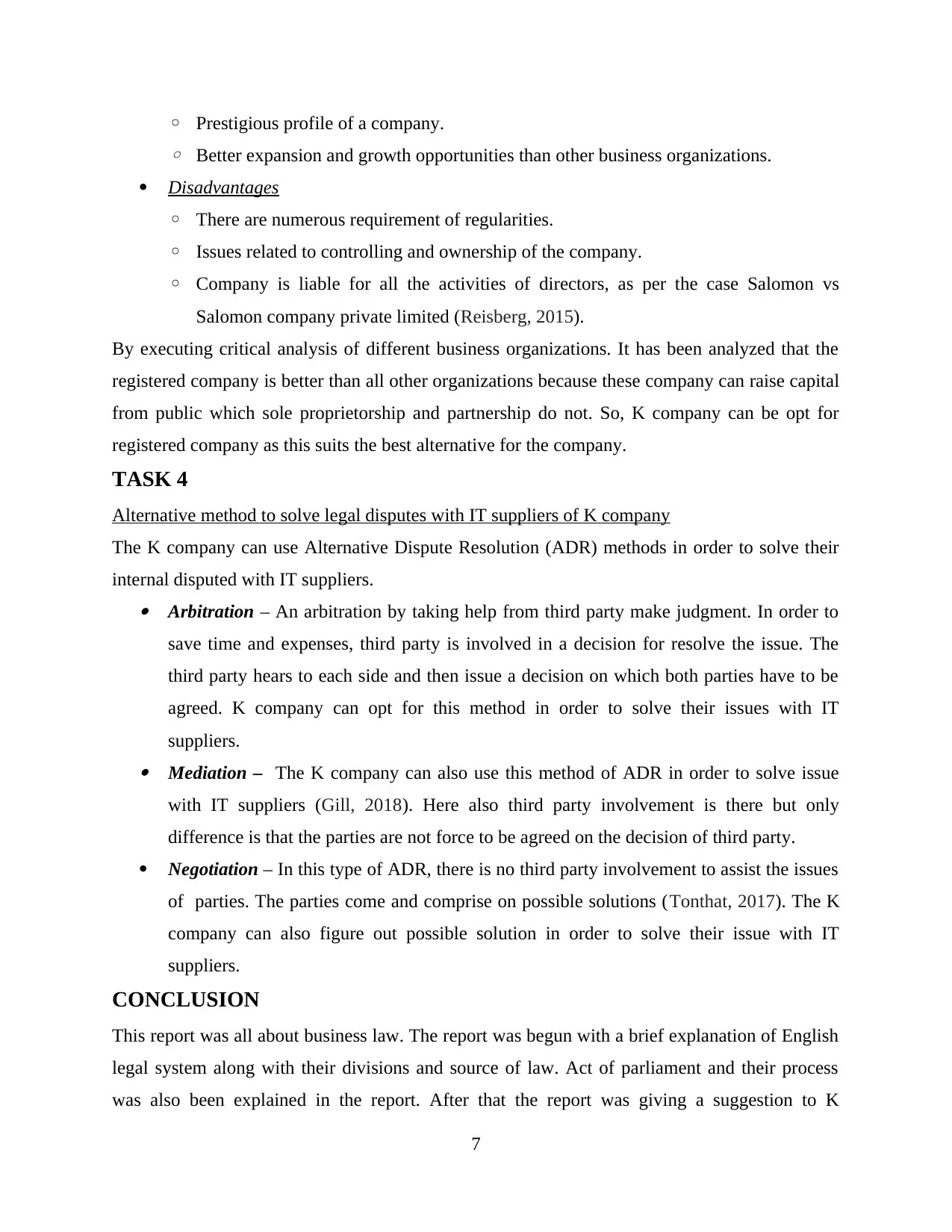
◦ Prestigious profile of a company.
◦ Better expansion and growth opportunities than other business organizations.
Disadvantages
◦ There are numerous requirement of regularities.
◦ Issues related to controlling and ownership of the company.
◦ Company is liable for all the activities of directors, as per the case Salomon vs
Salomon company private limited (Reisberg, 2015).
By executing critical analysis of different business organizations. It has been analyzed that the
registered company is better than all other organizations because these company can raise capital
from public which sole proprietorship and partnership do not. So, K company can be opt for
registered company as this suits the best alternative for the company.
TASK 4
Alternative method to solve legal disputes with IT suppliers of K company
The K company can use Alternative Dispute Resolution (ADR) methods in order to solve their
internal disputed with IT suppliers. Arbitration – An arbitration by taking help from third party make judgment. In order to
save time and expenses, third party is involved in a decision for resolve the issue. The
third party hears to each side and then issue a decision on which both parties have to be
agreed. K company can opt for this method in order to solve their issues with IT
suppliers. Mediation – The K company can also use this method of ADR in order to solve issue
with IT suppliers (Gill, 2018). Here also third party involvement is there but only
difference is that the parties are not force to be agreed on the decision of third party.
Negotiation – In this type of ADR, there is no third party involvement to assist the issues
of parties. The parties come and comprise on possible solutions (Tonthat, 2017). The K
company can also figure out possible solution in order to solve their issue with IT
suppliers.
CONCLUSION
This report was all about business law. The report was begun with a brief explanation of English
legal system along with their divisions and source of law. Act of parliament and their process
was also been explained in the report. After that the report was giving a suggestion to K
7
◦ Better expansion and growth opportunities than other business organizations.
Disadvantages
◦ There are numerous requirement of regularities.
◦ Issues related to controlling and ownership of the company.
◦ Company is liable for all the activities of directors, as per the case Salomon vs
Salomon company private limited (Reisberg, 2015).
By executing critical analysis of different business organizations. It has been analyzed that the
registered company is better than all other organizations because these company can raise capital
from public which sole proprietorship and partnership do not. So, K company can be opt for
registered company as this suits the best alternative for the company.
TASK 4
Alternative method to solve legal disputes with IT suppliers of K company
The K company can use Alternative Dispute Resolution (ADR) methods in order to solve their
internal disputed with IT suppliers. Arbitration – An arbitration by taking help from third party make judgment. In order to
save time and expenses, third party is involved in a decision for resolve the issue. The
third party hears to each side and then issue a decision on which both parties have to be
agreed. K company can opt for this method in order to solve their issues with IT
suppliers. Mediation – The K company can also use this method of ADR in order to solve issue
with IT suppliers (Gill, 2018). Here also third party involvement is there but only
difference is that the parties are not force to be agreed on the decision of third party.
Negotiation – In this type of ADR, there is no third party involvement to assist the issues
of parties. The parties come and comprise on possible solutions (Tonthat, 2017). The K
company can also figure out possible solution in order to solve their issue with IT
suppliers.
CONCLUSION
This report was all about business law. The report was begun with a brief explanation of English
legal system along with their divisions and source of law. Act of parliament and their process
was also been explained in the report. After that the report was giving a suggestion to K
7
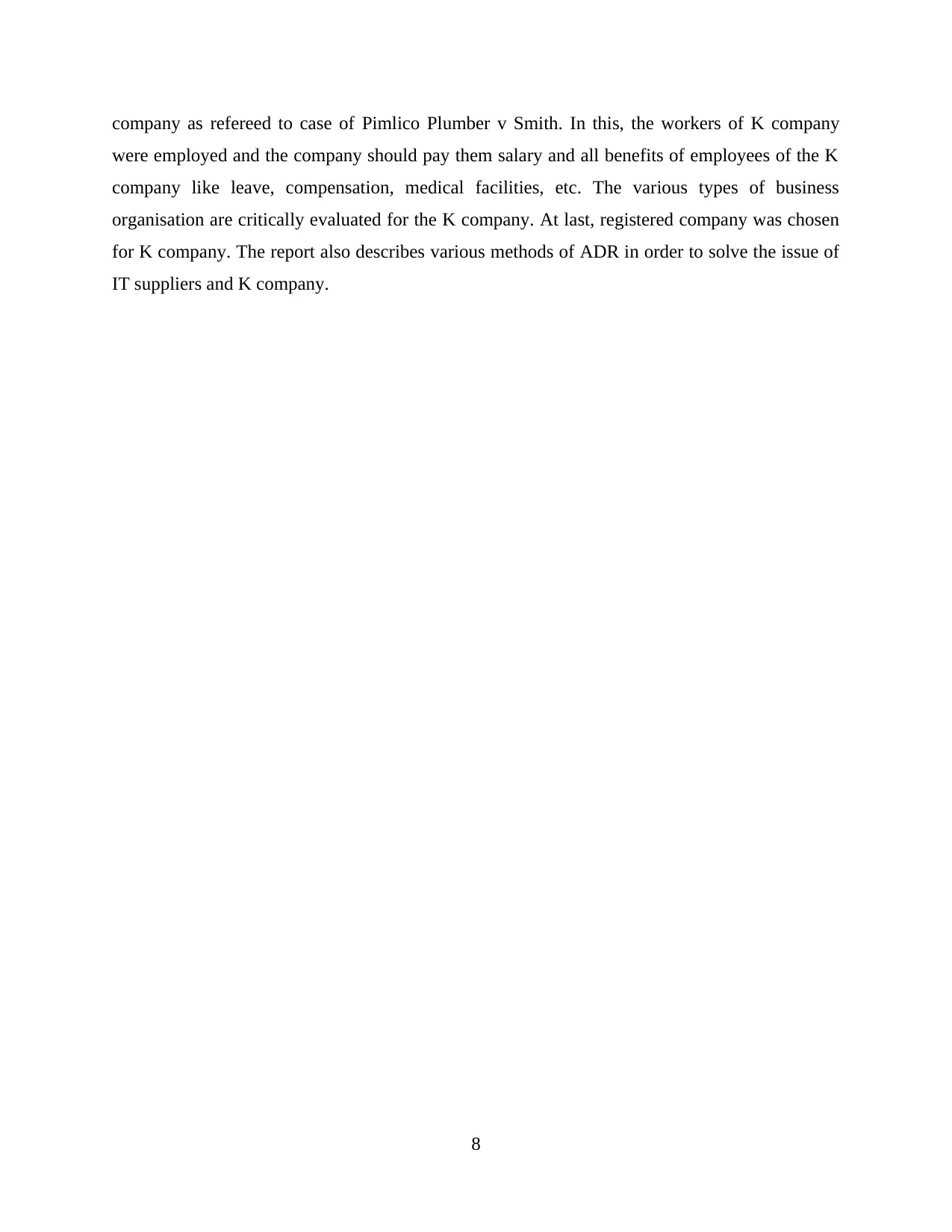
company as refereed to case of Pimlico Plumber v Smith. In this, the workers of K company
were employed and the company should pay them salary and all benefits of employees of the K
company like leave, compensation, medical facilities, etc. The various types of business
organisation are critically evaluated for the K company. At last, registered company was chosen
for K company. The report also describes various methods of ADR in order to solve the issue of
IT suppliers and K company.
8
were employed and the company should pay them salary and all benefits of employees of the K
company like leave, compensation, medical facilities, etc. The various types of business
organisation are critically evaluated for the K company. At last, registered company was chosen
for K company. The report also describes various methods of ADR in order to solve the issue of
IT suppliers and K company.
8
Secure Best Marks with AI Grader
Need help grading? Try our AI Grader for instant feedback on your assignments.
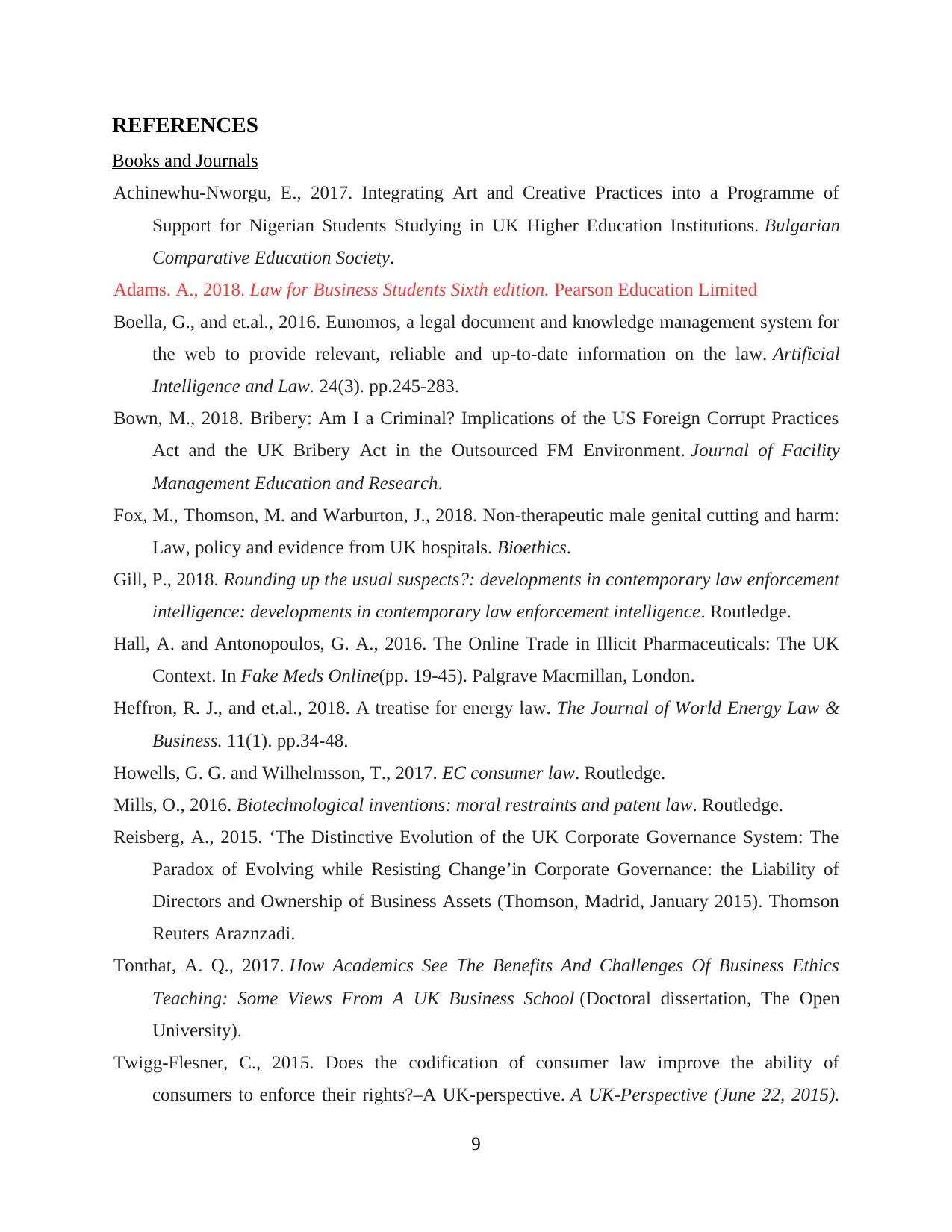
REFERENCES
Books and Journals
Achinewhu-Nworgu, E., 2017. Integrating Art and Creative Practices into a Programme of
Support for Nigerian Students Studying in UK Higher Education Institutions. Bulgarian
Comparative Education Society.
Adams. A., 2018. Law for Business Students Sixth edition. Pearson Education Limited
Boella, G., and et.al., 2016. Eunomos, a legal document and knowledge management system for
the web to provide relevant, reliable and up-to-date information on the law. Artificial
Intelligence and Law. 24(3). pp.245-283.
Bown, M., 2018. Bribery: Am I a Criminal? Implications of the US Foreign Corrupt Practices
Act and the UK Bribery Act in the Outsourced FM Environment. Journal of Facility
Management Education and Research.
Fox, M., Thomson, M. and Warburton, J., 2018. Non‐therapeutic male genital cutting and harm:
Law, policy and evidence from UK hospitals. Bioethics.
Gill, P., 2018. Rounding up the usual suspects?: developments in contemporary law enforcement
intelligence: developments in contemporary law enforcement intelligence. Routledge.
Hall, A. and Antonopoulos, G. A., 2016. The Online Trade in Illicit Pharmaceuticals: The UK
Context. In Fake Meds Online(pp. 19-45). Palgrave Macmillan, London.
Heffron, R. J., and et.al., 2018. A treatise for energy law. The Journal of World Energy Law &
Business. 11(1). pp.34-48.
Howells, G. G. and Wilhelmsson, T., 2017. EC consumer law. Routledge.
Mills, O., 2016. Biotechnological inventions: moral restraints and patent law. Routledge.
Reisberg, A., 2015. ‘The Distinctive Evolution of the UK Corporate Governance System: The
Paradox of Evolving while Resisting Change’in Corporate Governance: the Liability of
Directors and Ownership of Business Assets (Thomson, Madrid, January 2015). Thomson
Reuters Araznzadi.
Tonthat, A. Q., 2017. How Academics See The Benefits And Challenges Of Business Ethics
Teaching: Some Views From A UK Business School (Doctoral dissertation, The Open
University).
Twigg-Flesner, C., 2015. Does the codification of consumer law improve the ability of
consumers to enforce their rights?–A UK-perspective. A UK-Perspective (June 22, 2015).
9
Books and Journals
Achinewhu-Nworgu, E., 2017. Integrating Art and Creative Practices into a Programme of
Support for Nigerian Students Studying in UK Higher Education Institutions. Bulgarian
Comparative Education Society.
Adams. A., 2018. Law for Business Students Sixth edition. Pearson Education Limited
Boella, G., and et.al., 2016. Eunomos, a legal document and knowledge management system for
the web to provide relevant, reliable and up-to-date information on the law. Artificial
Intelligence and Law. 24(3). pp.245-283.
Bown, M., 2018. Bribery: Am I a Criminal? Implications of the US Foreign Corrupt Practices
Act and the UK Bribery Act in the Outsourced FM Environment. Journal of Facility
Management Education and Research.
Fox, M., Thomson, M. and Warburton, J., 2018. Non‐therapeutic male genital cutting and harm:
Law, policy and evidence from UK hospitals. Bioethics.
Gill, P., 2018. Rounding up the usual suspects?: developments in contemporary law enforcement
intelligence: developments in contemporary law enforcement intelligence. Routledge.
Hall, A. and Antonopoulos, G. A., 2016. The Online Trade in Illicit Pharmaceuticals: The UK
Context. In Fake Meds Online(pp. 19-45). Palgrave Macmillan, London.
Heffron, R. J., and et.al., 2018. A treatise for energy law. The Journal of World Energy Law &
Business. 11(1). pp.34-48.
Howells, G. G. and Wilhelmsson, T., 2017. EC consumer law. Routledge.
Mills, O., 2016. Biotechnological inventions: moral restraints and patent law. Routledge.
Reisberg, A., 2015. ‘The Distinctive Evolution of the UK Corporate Governance System: The
Paradox of Evolving while Resisting Change’in Corporate Governance: the Liability of
Directors and Ownership of Business Assets (Thomson, Madrid, January 2015). Thomson
Reuters Araznzadi.
Tonthat, A. Q., 2017. How Academics See The Benefits And Challenges Of Business Ethics
Teaching: Some Views From A UK Business School (Doctoral dissertation, The Open
University).
Twigg-Flesner, C., 2015. Does the codification of consumer law improve the ability of
consumers to enforce their rights?–A UK-perspective. A UK-Perspective (June 22, 2015).
9
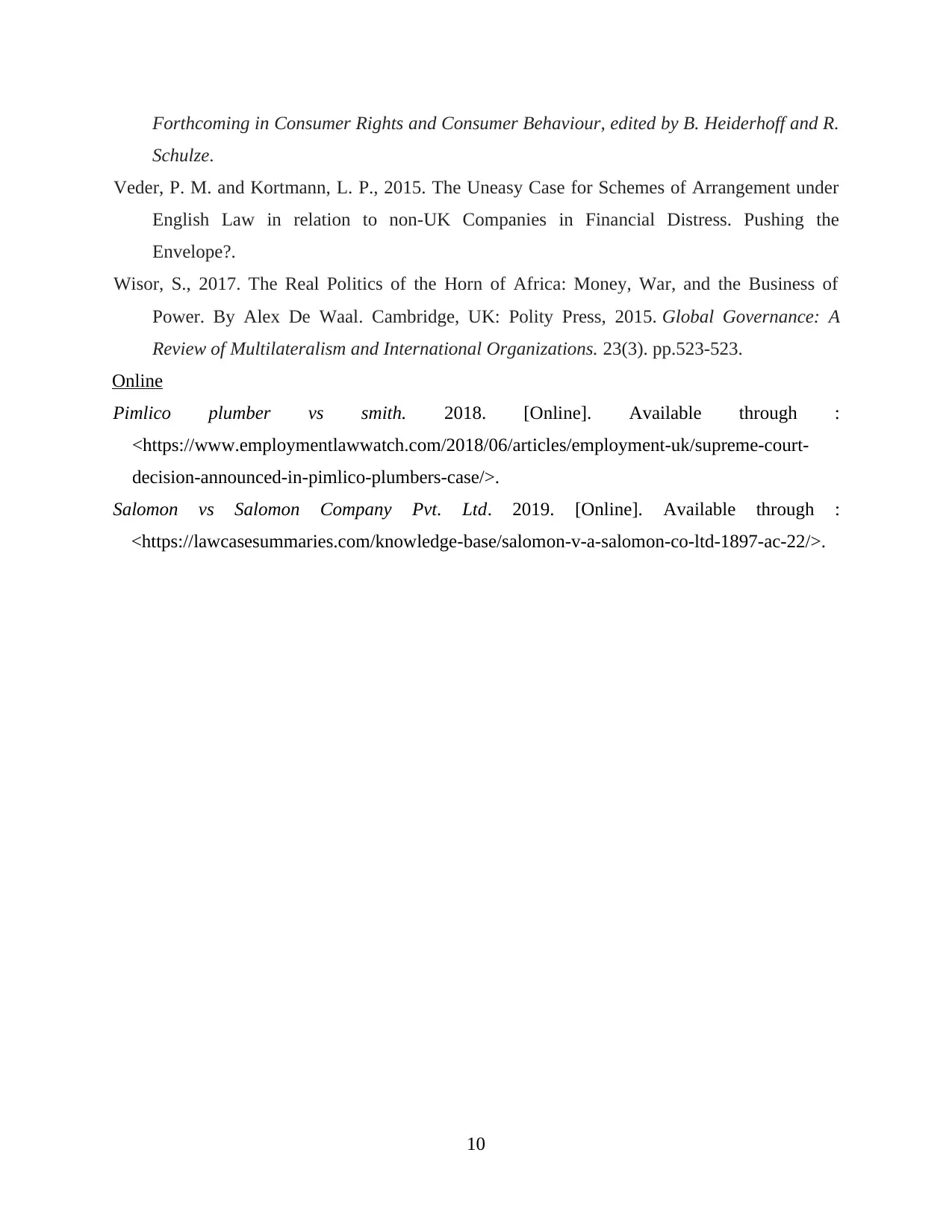
Forthcoming in Consumer Rights and Consumer Behaviour, edited by B. Heiderhoff and R.
Schulze.
Veder, P. M. and Kortmann, L. P., 2015. The Uneasy Case for Schemes of Arrangement under
English Law in relation to non-UK Companies in Financial Distress. Pushing the
Envelope?.
Wisor, S., 2017. The Real Politics of the Horn of Africa: Money, War, and the Business of
Power. By Alex De Waal. Cambridge, UK: Polity Press, 2015. Global Governance: A
Review of Multilateralism and International Organizations. 23(3). pp.523-523.
Online
Pimlico plumber vs smith. 2018. [Online]. Available through :
<https://www.employmentlawwatch.com/2018/06/articles/employment-uk/supreme-court-
decision-announced-in-pimlico-plumbers-case/>.
Salomon vs Salomon Company Pvt. Ltd. 2019. [Online]. Available through :
<https://lawcasesummaries.com/knowledge-base/salomon-v-a-salomon-co-ltd-1897-ac-22/>.
10
Schulze.
Veder, P. M. and Kortmann, L. P., 2015. The Uneasy Case for Schemes of Arrangement under
English Law in relation to non-UK Companies in Financial Distress. Pushing the
Envelope?.
Wisor, S., 2017. The Real Politics of the Horn of Africa: Money, War, and the Business of
Power. By Alex De Waal. Cambridge, UK: Polity Press, 2015. Global Governance: A
Review of Multilateralism and International Organizations. 23(3). pp.523-523.
Online
Pimlico plumber vs smith. 2018. [Online]. Available through :
<https://www.employmentlawwatch.com/2018/06/articles/employment-uk/supreme-court-
decision-announced-in-pimlico-plumbers-case/>.
Salomon vs Salomon Company Pvt. Ltd. 2019. [Online]. Available through :
<https://lawcasesummaries.com/knowledge-base/salomon-v-a-salomon-co-ltd-1897-ac-22/>.
10
1 out of 12
Related Documents
Your All-in-One AI-Powered Toolkit for Academic Success.
+13062052269
info@desklib.com
Available 24*7 on WhatsApp / Email
![[object Object]](/_next/static/media/star-bottom.7253800d.svg)
Unlock your academic potential
© 2024 | Zucol Services PVT LTD | All rights reserved.





